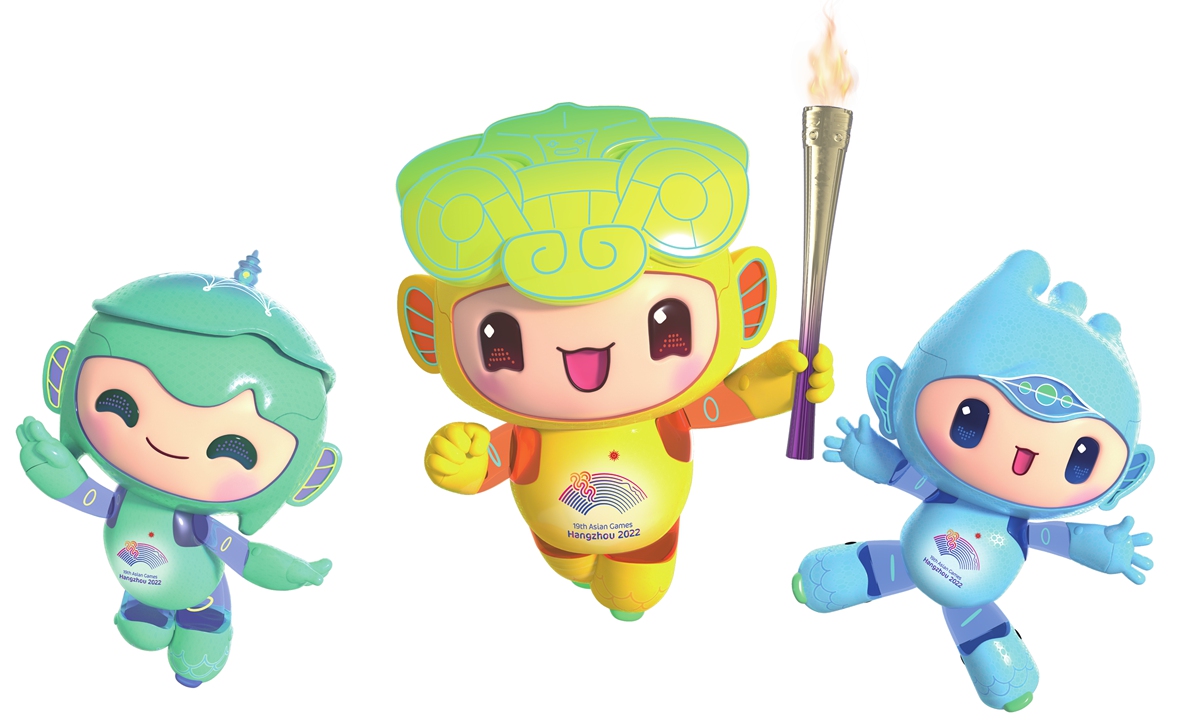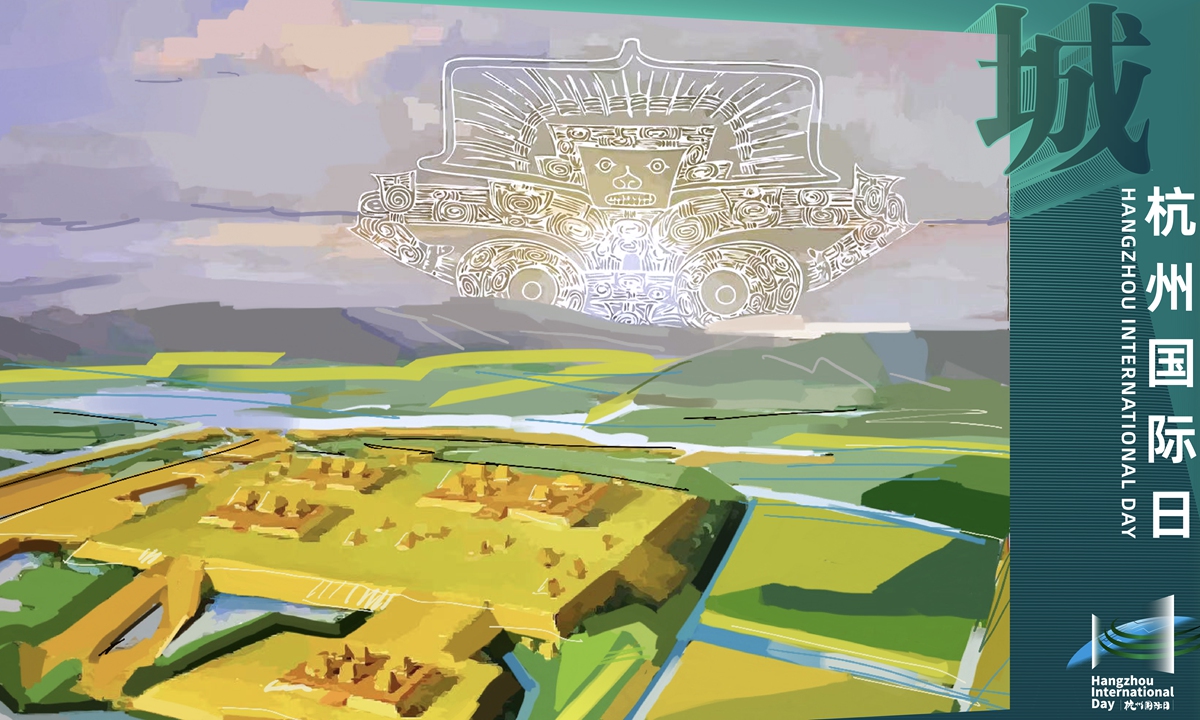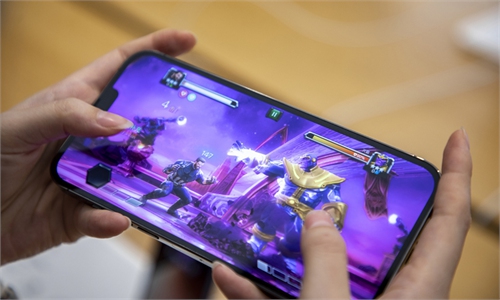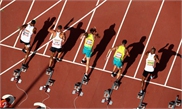ARTS / ART
Hangzhou creators decode the story behind mascots
The legendary muse

The mascots of 19th Asian Games Hangzhou 2022 Photo: Courtesy of Zhang Wen and Zhai Mofan

One of the posters designed for the 4th Hangzhou International Day Photo: Courtesy of Zhang Wen and Zhai Mofan
"Jiangnanyi," the group name for the three mascots created to mark the 19th Asian Games Hangzhou 2022, which will run from September 10 to 25, can now be seen frolicking around the city's public areas. Previously, digital art posters were used to promote the city's image during the 4th International Day in September, 2021. All of these unique works created to blend the city's cultural history with its vanguard digital techie nature send an invitation to world spectators, giving them a preview of the "smart" Asian Games that will be on offer in China come September.
Decoding the 'robots'
The three mascots - Cong Cong, Lian Lian and Chen Chen - officially made their world debut online earlier in April. The three little "robots" in yellow, green and blue with cute smiling faces were brought to life in 2019 by Zhang Wen, a veteran designer at the China Academy of Art whose designs were chosen from among 4,600 mascots pitches.
Zhang revealed to the Global Times that during the design stage, they originally thought about basing the characters on fish, as Hangzhou is one of the most prosperous cities in Jiangnan, the region south of the Yangtze River traditionally considered "the land of fish and rice."
The idea, however, was quickly updated to a robot to better interpret Hangzhou as it is today: a first-tier city with E-information as its major pillar of industry.
"The attributes of the city should be seen in the design. The face of modern Hangzhou should be valued the same as its history," Zhang noted.
Sketching these urban robots with his fellow designer and wife Yang Yihong, Zhang completed a first draft after two weeks of walking around the city and taking in its culture and history.
"We were very clear at the beginning that we should add visual elements that symbolize the cultural and historical depth of Hangzhou, this was an unchanging guide," said Zhang.
The creative pairs' inquiry into local culture landed on three major scenic spots - the world cultural heritage site Archaeological Ruins of Liangzhu City, the West Lake and the Grand Canal.
According to Zhang, Cong Cong's matte yellow color was inspired by the texture of the Yu Cong, an ancient jade ritual vessel discovered in the Ruins of Liangzhu City. The lotus flowers in the West Lake provided inspiration for the lotus leaf hat worn by Lian Lian, whose name also means lotus. A florescent blue color was chosen for Chen Chen, the bubbliest one among the group, to refer to the landmark Gongchen Bridge that crosses the Grand Canal, the world's longest man-made waterway.
"Cong Cong shows the long-established cultural prosperity of China, it belongs to the past; the canal theme for Chen Chen symbolizes the courage to ride the waves and develop the city and communicate with the world; Lian Lian represents the natural ecology of Hangzhou as a green city," Zhang said.
"Behind it all… is our confidence in Chinese culture."
Finding inspiration
Zhang and his wife are not the only creators who see the city as a muse for their artistic creations.
Zhai Mofan, a prominent young oil painter who places great value on art's ability to communicate with the world also pitched his own mascot design in 2019. His "Xi Xi" and "Hu Hu" were inspired by the West Lake and the Qiantang River.
"I chose the West Lake because it is not only beautiful, but also accompanies me every day and supports the city's development," Zhai noted.
Zhai, a vanguardist studying historical and thematic painting, told the Global Times that he experienced even a moment's reluctance about putting effort into designing mascots for the city even though he knew they may not be selected. He said he felt it was his responsibility to be an outsider artist who observes society through the lens of art.
"Painting should also be pragmatic by serving society and the development of humanity. No matter if it is a thematic or historical painting, it should be in step with the current times to reflect how they have changed."
He has never stopped his innovative art experiments to promote the city's culture.
In 2021, he joined an art project led by Professor Wu Dayong of the China Academy of Art to design a poster collection for the 4th Hangzhou International Day. Numerous artists submitted posters that used a vast array or mediums such as computer design or oil painting to depict interesting stories like Marco Polo at West Lake, which imaginatively depicts the Italian voyager who once called Hangzhou the "most beautiful city in the world" at the iconic lake to symbolize the city's openness to international communication.
"This is what we do. The mascot designs are like an invitation to welcome people around the world to come explore China," said Zhang.



